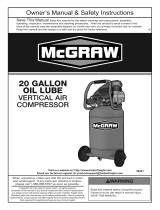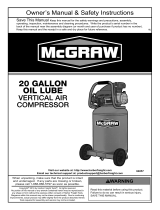Central Pneumatic 62299 Air Compressor Owner's manual
- Category
- Air compressors
- Type
- Owner's manual
This manual is also suitable for
Central Pneumatic 62299 Air Compressor is a powerful and versatile tool that can be used for a variety of tasks around the home or workshop. With its 60-gallon tank, it can provide plenty of air for extended use, and its 15.8 SCFM @ 90 PSI air production means that it can power even the most demanding air tools. The compressor is also relatively quiet, with a sound level of only 86 dB at 3 feet, making it ideal for use in residential areas. Additionally, the compressor is easy to set up and use, with a simple control panel and a variety of features that make it safe and convenient to operate.
Central Pneumatic 62299 Air Compressor is a powerful and versatile tool that can be used for a variety of tasks around the home or workshop. With its 60-gallon tank, it can provide plenty of air for extended use, and its 15.8 SCFM @ 90 PSI air production means that it can power even the most demanding air tools. The compressor is also relatively quiet, with a sound level of only 86 dB at 3 feet, making it ideal for use in residential areas. Additionally, the compressor is easy to set up and use, with a simple control panel and a variety of features that make it safe and convenient to operate.




















-
 1
1
-
 2
2
-
 3
3
-
 4
4
-
 5
5
-
 6
6
-
 7
7
-
 8
8
-
 9
9
-
 10
10
-
 11
11
-
 12
12
-
 13
13
-
 14
14
-
 15
15
-
 16
16
-
 17
17
-
 18
18
-
 19
19
-
 20
20
Central Pneumatic 62299 Air Compressor Owner's manual
- Category
- Air compressors
- Type
- Owner's manual
- This manual is also suitable for
Central Pneumatic 62299 Air Compressor is a powerful and versatile tool that can be used for a variety of tasks around the home or workshop. With its 60-gallon tank, it can provide plenty of air for extended use, and its 15.8 SCFM @ 90 PSI air production means that it can power even the most demanding air tools. The compressor is also relatively quiet, with a sound level of only 86 dB at 3 feet, making it ideal for use in residential areas. Additionally, the compressor is easy to set up and use, with a simple control panel and a variety of features that make it safe and convenient to operate.
Ask a question and I''ll find the answer in the document
Finding information in a document is now easier with AI
Related papers
-
Central Pneumatic 62803 Owner's manual
-
Harbor Freight Tools Item 93274 Owner's manual
-
Central Pneumatic 69667 Owner's manual
-
Central Pneumatic Item 63635 Owner's manual
-
Harbor Freight Tools 61454 Owner's manual
-
Central Pneumatic 61454 Owner's manual
-
Central Pneumatic Item 62441 Owner's manual
-
Central Pneumatic 62763 Air Compressor Owner's manual
-
Central Pneumatic 40211 Owner's manual
-
Central Pneumatic Item 62802 Owner's manual
Other documents
-
NORTHSTAR Electric Air Compressor, 3.7 HP, 230 Volt, 1 Phase, 60-Gallon Vertical Tank Owner's manual
-
Stark 65151 User guide
-
Vixen Horns Heavy Duty Onboard Air Compressor 200 PSI. Universal Replacement for Truck/Car Train Horn/Suspension/Ride/Bag kit/System. Fits All 12v Vehicles Like Semi/Pickup Trucks/Jeep VXC8301 User manual
-
General International AC1106 User guide
-
Fortress Item 56402 Owner's manual
-
Harbor Freight Tools 10 gal 2.5 HP 125 PSI Oil Lube Air Compressor User manual
-
Harbor Freight Tools 21 gal. 2_1/2 HP 125 PSI Cast Iron Vertical Air Compressor User manual
-
Pittsburgh Automotive Item 69814-UPC 792363698146 Owner's manual
-
 McGraw Item 56241 Owner's manual
McGraw Item 56241 Owner's manual
-
 McGraw Item 64857 Owner's manual
McGraw Item 64857 Owner's manual





















